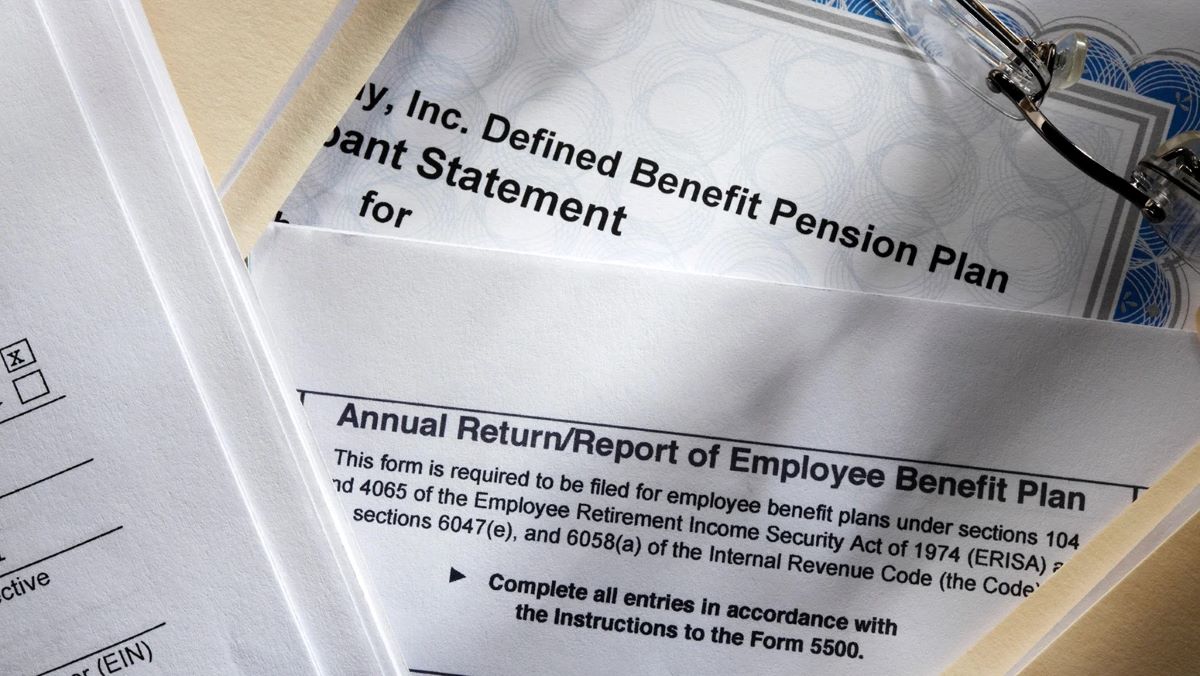Home>Finance>How Do You Measure If There Is Too Much Or Too Little Debt In Capital Structure


Finance
How Do You Measure If There Is Too Much Or Too Little Debt In Capital Structure
Modified: February 21, 2024
Learn how to measure the adequacy of debt in your capital structure with our finance guide. Find out if there's too much or too little debt for your business.
(Many of the links in this article redirect to a specific reviewed product. Your purchase of these products through affiliate links helps to generate commission for LiveWell, at no extra cost. Learn more)
Table of Contents
- Introduction
- Importance of Debt in Capital Structure
- Factors to Consider in Measuring Debt Levels
- Debt-to-Equity Ratio
- Debt-to-Asset Ratio
- Interest Coverage Ratio
- Fixed Charge Coverage Ratio
- Debt Service Coverage Ratio
- Debt-to-Income Ratio
- Other Key Indicators
- Consequences of Excessive Debt
- Consequences of Insufficient Debt
- Finding the Optimal Debt Level
- Conclusion
Introduction
Debt plays a crucial role in the capital structure of a company, as it provides the necessary funds for growth, expansion, and day-to-day operations. However, determining the right amount of debt can be a challenging task for organizations. It is essential to find a balance that ensures financial stability and flexibility, without burdening the company with excessive debt obligations.
The optimal capital structure varies from company to company, depending on factors such as industry, business model, growth prospects, and risk appetite. Too much debt can increase financial risk, strain cash flows, and hinder the ability to invest in future opportunities. On the other hand, too little debt may limit a company’s growth potential and hinder its ability to exploit opportunities efficiently.
In order to measure if there is too much or too little debt in the capital structure, various financial metrics and ratios are used. These indicators provide insights into the extent of reliance on debt financing and help in assessing the risks associated with the company’s debt levels.
In this article, we will explore some of the key metrics used to measure the appropriate debt levels in a company’s capital structure. By understanding these metrics, businesses can gain valuable insights into their financial health and make informed decisions regarding their debt financing strategies.
It is important to note that while these metrics can provide useful guidance, they should be used in conjunction with a thorough analysis of the company’s specific circumstances and industry norms. Additionally, it is recommended to consult with financial advisors or professionals to ensure a comprehensive and accurate assessment of the ideal debt level for a company.
Importance of Debt in Capital Structure
Debt is a crucial component of a company’s capital structure because it allows businesses to finance their operations, invest in growth, and manage liquidity. While equity represents ownership in the company, debt represents borrowed money that must be repaid with interest over a specified period of time. Here are some key reasons why debt is essential in the capital structure:
1. Access to Capital: Debt provides a readily available source of capital that can be used to fund various business initiatives. Whether it’s acquiring assets, expanding operations, or investing in research and development, debt can provide the necessary funds to fuel growth and take advantage of market opportunities.
2. Tax Benefits: One significant advantage of debt is the tax deductibility of interest payments. Interest expenses can be deducted from the company’s taxable income, which reduces its overall tax liability. This tax shield can effectively lower the cost of debt and make it a more attractive financing option for companies.
3. Preservation of Ownership: By utilizing debt financing, businesses can maintain ownership and control over their operations. Unlike equity financing, where ownership is diluted with the issuance of new shares, debt allows companies to retain their existing ownership structure. This can be particularly important for entrepreneurs and founders who want to maintain control of the business.
4. Flexibility: Debt offers greater flexibility compared to equity financing. Companies have the freedom to structure the terms of debt agreements, such as interest rates, repayment schedules, and collateral requirements, to align with their specific needs and cash flow capabilities. This flexibility allows businesses to manage their financial obligations in a manner that best suits their circumstances.
5. Investor Perception: The presence of debt in a capital structure can be perceived positively by investors. It demonstrates that the company has access to external funding sources and can attract lenders based on its creditworthiness. This perception of financial stability and confidence can enhance the company’s reputation and make it more attractive to potential investors.
While debt plays a crucial role in the capital structure, it is important for companies to strike the right balance between debt and equity. Excessive debt can increase financial risk, put undue pressure on cash flows, and limit financial flexibility. On the other hand, too little debt may indicate underutilization of opportunities, reliance on costly equity financing, and potential missed growth prospects.
By understanding the importance of debt in the capital structure and carefully managing their debt levels, companies can effectively optimize their financial structure and position themselves for sustainable growth and profitability.
Factors to Consider in Measuring Debt Levels
Measuring debt levels in a company’s capital structure requires a comprehensive analysis of various factors that contribute to the overall financial health and risk profile of the business. By considering these factors, businesses can assess their debt capacity and determine if they have too much or too little debt. Here are some key factors to consider when measuring debt levels:
1. Industry and Competitive Landscape: Different industries have varying levels of debt tolerance. It is essential to understand the typical debt-to-equity ratios and debt levels within the industry to gauge if the company is in line with industry norms. Additionally, assessing the competitive landscape can help determine the optimal debt level needed to stay competitive and invest in growth opportunities.
2. Business Lifecycle and Growth Prospects: Companies in different stages of the business lifecycle have distinct debt requirements. Start-ups and high-growth companies may require more debt to fund expansion plans, while mature companies may aim for a more conservative debt structure to ensure stability and manage cash flows. Evaluating growth prospects and future revenue streams is crucial in determining the appropriate debt level.
3. Cash Flow and Profitability: A company’s ability to generate consistent and sufficient cash flows to cover debt obligations is a fundamental factor in assessing debt levels. Cash flow measures, such as operating cash flow, free cash flow, and debt service coverage ratio, help determine whether a company has the means to service its debt. Profitability measures, such as gross profit margin and net profit margin, provide insights into the company’s ability to generate earnings to support debt payments.
4. Asset Quality and Collateral: The presence of tangible assets that can serve as collateral for loans provides lenders with a level of security in case of default. Companies with high-quality assets may be able to secure lower interest rates and more favorable debt terms. Assessing the value and quality of assets is essential to determine the appropriate debt levels and the level of risk associated with the collateral.
5. Risk Tolerance and Cost of Capital: Different companies have varying risk tolerances and cost of capital expectations. Understanding the company’s risk appetite and cost of capital preferences can influence the optimal debt level. Companies with a lower risk tolerance may prefer a lower debt-to-equity ratio to maintain financial stability, while others may be willing to take on more debt to pursue aggressive growth strategies.
6. Regulatory and Legal Considerations: Certain industries or jurisdictions may have specific regulations or limitations on debt levels. It is important to consider these regulations when assessing the appropriate debt level to ensure compliance and avoid legal or regulatory repercussions.
By taking these factors into account, businesses can gain a comprehensive understanding of their debt levels. It is crucial to strike a balance between leveraging debt for growth and ensuring financial stability. Regularly monitoring and reassessing debt levels in light of these factors is essential to maintain a healthy capital structure.
Debt-to-Equity Ratio
The debt-to-equity ratio is a key financial metric used to evaluate the proportion of debt relative to equity in a company’s capital structure. It is calculated by dividing the total debt of a company by its shareholders’ equity. The resulting ratio indicates the level of financial leverage employed by the company and provides insights into its risk profile.
A high debt-to-equity ratio suggests that a company relies heavily on debt to finance its operations and investments. This can indicate a higher level of financial risk, as a significant portion of the company’s capital structure is funded through debt obligations. It also implies that a larger portion of the company is owned by creditors rather than shareholders.
On the other hand, a low debt-to-equity ratio indicates that a company has a smaller proportion of debt relative to its equity. This generally implies a lower level of financial risk and a higher degree of financial stability. It also suggests that shareholders have a larger ownership stake in the company.
The optimal debt-to-equity ratio varies across industries and depends on various factors such as the company’s risk tolerance, growth prospects, and the prevailing market conditions. Companies operating in industries with stable cash flows and low financial risk may have a lower debt-to-equity ratio, while companies in industries with higher risk or growth potential may have a higher ratio.
It is important to note that the debt-to-equity ratio should be interpreted in the context of the company’s specific circumstances and industry norms. While a higher debt-to-equity ratio may indicate a riskier financial position, it may be acceptable or even desirable in certain situations. For example, companies in capital-intensive industries, such as utilities or infrastructure, may require higher debt levels to finance their long-term assets.
Analysts and investors often compare a company’s debt-to-equity ratio to industry benchmarks or historical trends to assess its relative financial position. A significant deviation from these benchmarks may raise concerns or warrant further investigation into the company’s financial health and risk management practices.
It is essential for companies to regularly monitor and manage their debt-to-equity ratio to ensure a healthy and sustainable capital structure. A balanced debt-to-equity ratio provides the company with the necessary financial flexibility to support growth while also safeguarding against excessive financial risk.
Debt-to-Asset Ratio
The debt-to-asset ratio is a financial indicator that measures the proportion of a company’s total assets that are financed by debt. It provides insights into the extent to which a company relies on borrowed funds to support its operations and investments. The debt-to-asset ratio is calculated by dividing the total debt of the company by its total assets.
A higher debt-to-asset ratio indicates a greater degree of reliance on debt financing. This implies that a significant portion of the company’s assets is financed by debt obligations. A high ratio may suggest a higher level of financial risk, as the company may have a larger debt burden to manage. It also indicates that creditors have a significant stake in the company’s assets.
Conversely, a lower debt-to-asset ratio suggests that a company has a smaller proportion of debt relative to its total assets. This generally signifies a lower level of financial risk and a stronger financial position. It indicates that the company relies more on equity financing and has a larger proportion of its assets owned by shareholders.
Similar to the debt-to-equity ratio, the optimal debt-to-asset ratio varies across industries and depends on factors such as the company’s risk tolerance, growth prospects, and prevailing market conditions. Industries with stable cash flows and low risk levels may typically have lower debt-to-asset ratios, while industries that require significant investments or have higher risk profiles may have higher ratios.
When comparing the debt-to-asset ratio of a company to industry peers or historical trends, it is important to consider industry-specific characteristics and economic factors. Additionally, it is necessary to compare companies within the same industry, as the acceptable range of debt-to-asset ratios may vary significantly between different sectors.
It is crucial to bear in mind that both a high and low debt-to-asset ratio have their own implications. A high ratio may indicate potential financial distress and the need for additional risk management measures. On the other hand, a low ratio may suggest underutilization of debt financing and missed opportunities for growth.
Companies must strike a balance between debt and assets to optimize their financial structure. This includes considering the cost of debt, asset productivity, and the ability to generate cash flows to service debt obligations. Regular evaluation and monitoring of the debt-to-asset ratio can help companies assess their risk exposure, make informed financing decisions, and ensure a healthy capital structure.
Interest Coverage Ratio
The interest coverage ratio is a financial metric that measures a company’s ability to cover its interest expenses with its operating income. It provides insights into the company’s ability to generate enough earnings to meet its interest obligations. The interest coverage ratio is calculated by dividing the company’s earnings before interest and taxes (EBIT) by its interest expenses.
A higher interest coverage ratio indicates a greater ability to cover interest payments and suggests a lower level of financial risk. It implies that the company’s earnings are comfortably sufficient to service its interest obligations. A high interest coverage ratio is generally viewed as a positive sign by lenders, investors, and other stakeholders, as it demonstrates the company’s ability to generate consistent profits and meet its debt obligations.
Conversely, a lower interest coverage ratio indicates a higher risk of default on interest payments. It suggests that the company’s earnings may not be enough to cover its interest expenses. A low interest coverage ratio can raise concerns among stakeholders about the company’s financial stability and ability to manage its debt obligations.
It is important to note that the acceptable range for the interest coverage ratio may vary across industries and depend on factors such as the company’s risk profile, industry norms, and prevailing interest rates. Industries with stable cash flows and low financial risk may have higher interest coverage ratios, while industries with higher risk or cyclicality may have lower ratios.
Investors and lenders often use the interest coverage ratio to assess a company’s creditworthiness and financial health. A ratio below industry benchmarks or historical trends may signal potential financial distress or an overburdened capital structure. On the other hand, a ratio that is comfortably above industry standards may indicate strong financial health and lower risk.
It is important to interpret the interest coverage ratio in conjunction with other financial indicators and factors specific to the company and its industry. While a high interest coverage ratio is generally desirable, excessively high ratios may indicate underinvestment or missed growth opportunities. Similarly, very low ratios may suggest excessive debt burden and potential liquidity issues.
Regular monitoring of the interest coverage ratio is vital to assess changes in a company’s financial position and identify potential risks or areas of improvement. It helps management make informed decisions about debt management, capital structure, and overall financial strategy.
Overall, a healthy interest coverage ratio indicates that a company has sufficient earnings to fulfill its interest obligations consistently. It is a critical measure of a company’s financial stability and lenders’ confidence in its ability to repay debt.
Fixed Charge Coverage Ratio
The fixed charge coverage ratio is a financial metric that measures a company’s ability to cover its fixed charges, including interest expenses, lease payments, and other fixed obligations, with its earnings before interest, taxes, depreciation, and amortization (EBITDA). It provides insights into the company’s ability to generate sufficient cash flow to cover its fixed expenses. The fixed charge coverage ratio is calculated by dividing EBITDA by the sum of interest expenses and lease payments.
A higher fixed charge coverage ratio indicates a greater ability to cover fixed expenses and suggests a lower level of financial risk. It signifies that the company’s earnings are comfortably sufficient to meet its fixed obligations. A high fixed charge coverage ratio is generally viewed positively by lenders, investors, and other stakeholders, as it reflects the company’s strong cash flow generation and its ability to meet its financial commitments.
Conversely, a lower fixed charge coverage ratio suggests a higher risk of default on fixed expenses. It implies that the company’s earnings may not be sufficient to cover its fixed obligations. A low fixed charge coverage ratio can raise concerns about the company’s financial stability and its ability to manage its fixed obligations.
Similar to other financial ratios, the acceptable range for the fixed charge coverage ratio may vary across industries and depend on factors such as the company’s risk profile, industry norms, and macroeconomic conditions. Industries with stable cash flows and lower financial risk may generally have higher fixed charge coverage ratios, while industries with higher risk or cyclical nature may have lower ratios.
The fixed charge coverage ratio is an essential metric for lenders and investors to assess a company’s ability to meet its fixed obligations. It helps evaluate the creditworthiness and financial health of the company. A high fixed charge coverage ratio provides assurance that the company has a strong capacity to service its fixed expenses and manage its debt obligations.
However, it is important to consider other financial factors in conjunction with the fixed charge coverage ratio. For example, a high fixed charge coverage ratio does not necessarily mean that the company has healthy overall financial health if it is saddled with excessive debt or other financial constraints.
Regular monitoring of the fixed charge coverage ratio is crucial to identify any potential fluctuations or trends that may impact the company’s financial stability. It helps management make informed decisions about debt management, lease agreements, and other fixed obligations to maintain a healthy capital structure and mitigate financial risks.
In summary, the fixed charge coverage ratio is a vital measure of a company’s ability to meet its fixed expenses. It provides insights into the company’s financial health and its ability to fulfill its fixed obligations. By analyzing this ratio, stakeholders can make informed decisions regarding a company’s creditworthiness and financial stability.
Debt Service Coverage Ratio
The debt service coverage ratio (DSCR) is a financial metric used to assess a company’s ability to repay its debt obligations. It measures the company’s cash flow availability to cover its debt service requirements, including principal and interest payments. The debt service coverage ratio is calculated by dividing the company’s operating income (or net operating income) by its total debt service.
A higher debt service coverage ratio indicates a stronger ability to meet debt obligations. It reflects that the company generates a sufficient cash flow to comfortably cover its debt service requirements. This demonstrates financial stability and reassures lenders that the company can fulfill its debt obligations on time.
On the other hand, a lower debt service coverage ratio indicates a higher risk of default on debt payments. It implies that the company may have limited cash flow available to service its debts, which increases the likelihood of missed or delayed payments. A low debt service coverage ratio can raise concerns among lenders about the company’s ability to manage its debt and meet its financial obligations.
The optimal debt service coverage ratio varies across industries and depends on factors such as the company’s risk profile, industry norms, and the terms of debt agreements. Lenders typically have their own minimum required DSCR, and companies must meet or exceed this threshold to maintain a healthy financial position.
Analysts and investors use the debt service coverage ratio to assess a company’s debt repayment capacity and financial health. It helps in evaluating the company’s ability to manage its debt load and generate sufficient cash flow to meet its financial obligations. A high debt service coverage ratio is typically viewed as favorable, indicating a lower risk of default and stronger financial health.
However, it is essential to note that the debt service coverage ratio should be interpreted in conjunction with other financial factors. A high ratio does not necessarily mean the company is in excellent financial health if it faces other financial risks or has limited growth prospects. Conversely, a somewhat lower ratio may be acceptable if the company has stable cash flows, strong collateral, or a solid business outlook.
Regular monitoring of the debt service coverage ratio is crucial to identify any potential cash flow constraints or changes in the company’s financial position. By monitoring the ratio over time, management can assess trends and make informed decisions regarding debt management, capital structure, and overall financial strategy.
In summary, the debt service coverage ratio provides valuable insights into a company’s ability to meet its debt obligations. It is a vital measure for lenders, investors, and stakeholders as they evaluate the company’s creditworthiness and financial stability.
Debt-to-Income Ratio
The debt-to-income ratio (DTI) is a financial measure that compares an individual’s or a company’s debt obligations to its income. It is commonly used by lenders and financial institutions to assess an individual’s or a company’s ability to manage and repay its debts. The debt-to-income ratio is calculated by dividing the total debt obligations by the total income.
For individuals, the debt-to-income ratio measures the percentage of their monthly income that goes towards debt repayment. It includes all forms of debt such as mortgage payments, car loans, student loans, and credit card payments. Lenders use this ratio to evaluate the borrower’s capacity to handle additional debt and to determine their creditworthiness.
For companies, the debt-to-income ratio is used to assess the proportion of a company’s income that is utilized for servicing its debt obligations. It provides insights into the company’s ability to generate sufficient income to cover its debt payments. Lenders and investors use this ratio to evaluate the company’s financial health and its ability to manage its debt load.
A lower debt-to-income ratio indicates a healthier financial position, as it implies that a smaller portion of the income is dedicated to debt payments. This suggests that the individual or the company has a better ability to manage its debt obligations and may have a lower risk of default.
On the other hand, a higher debt-to-income ratio suggests a higher level of debt burden relative to the income. This indicates that a larger portion of the income is allocated towards debt repayment, leaving less available for other expenses or investment opportunities. A high debt-to-income ratio may raise concerns among lenders about the individual or company’s ability to take on additional debt or meet future financial obligations.
The acceptable range for the debt-to-income ratio can vary depending on factors such as the individual’s or company’s risk profile, income stability, and industry norms. Lenders typically have their own maximum allowable DTI thresholds, and individuals or companies must fall within these limits to secure financing or maintain a healthy financial position.
It is important for individuals and companies to regularly monitor their debt-to-income ratio to ensure a sustainable financial position. By keeping the debt-to-income ratio within acceptable limits, individuals can maintain better control over their financial obligations and improve their borrowing capacity. For companies, managing the debt-to-income ratio can help mitigate financial risks and maintain a healthy cash flow.
In summary, the debt-to-income ratio is a crucial measure of an individual’s or a company’s financial health. By evaluating this ratio, lenders and individuals alike can assess the ability to manage debt obligations and make informed financial decisions.
Other Key Indicators
In addition to the commonly used debt metrics such as the debt-to-equity ratio and debt service coverage ratio, several other key indicators can provide further insights into a company’s debt levels and financial health. These indicators help evaluate different aspects of a company’s capital structure and its ability to manage its debt obligations. Here are some of the other key indicators:
1. Debt-to-EBITDA Ratio: The debt-to-EBITDA ratio compares a company’s total debt to its earnings before interest, taxes, depreciation, and amortization (EBITDA). It provides a measure of a company’s ability to repay its debt based on its operating cash flow. A lower ratio indicates a lower level of financial risk, as it suggests that the company’s earnings are sufficient to service its debt obligations.
2. Current Ratio: The current ratio measures a company’s ability to cover its short-term liabilities with its short-term assets. It is calculated by dividing current assets by current liabilities. A higher current ratio indicates a greater ability to meet short-term debt obligations. It signifies a stronger liquidity position, as it suggests that the company has enough current assets to cover its immediate financial obligations.
3. Quick Ratio: The quick ratio, also known as the acid-test ratio, is similar to the current ratio but excludes inventory from current assets. It provides a more conservative measure of a company’s ability to meet short-term obligations without relying on the sale of inventory. A higher quick ratio indicates a stronger liquidity position and suggests a lower level of vulnerability to immediate debt obligations.
4. Debt-to-Capitalization Ratio: The debt-to-capitalization ratio compares a company’s total debt to its total capitalization, which includes both debt and equity. It indicates the proportion of a company’s total capital structure that is funded by debt. This ratio provides a comprehensive measure of the company’s reliance on debt financing. A higher ratio implies a higher level of debt and financial risk, while a lower ratio indicates a greater proportion of equity funding.
5. Equity Multiplier: The equity multiplier measures the extent to which a company’s assets are funded by shareholders’ equity. It is calculated by dividing total assets by total equity. A higher equity multiplier suggests a larger proportion of debt financing relative to equity, indicating higher financial risk. Conversely, a lower equity multiplier indicates a larger proportion of equity funding and may suggest a more conservative capital structure.
6. Debt Maturity Profile: The debt maturity profile analyzes the timing and distribution of a company’s debt repayments. It provides insights into the company’s ability to manage its debt obligations over time. By assessing the maturity schedule, a company can identify potential refinancing needs, evaluate its cash flow requirements, and mitigate the risks associated with a large concentration of debt repayments in a specific period.
These key indicators provide valuable insights into a company’s financial health, risk profile, and debt management practices. By using a combination of these indicators, investors, lenders, and company management can gain a comprehensive understanding of the company’s capital structure and make informed decisions regarding debt financing, risk management, and overall financial strategy.
Consequences of Excessive Debt
Excessive debt can have detrimental effects on a company’s financial health and overall business operations. While debt can be a useful tool for growth and financing opportunities, having too much debt can lead to various consequences that can negatively impact a company. Here are some of the key consequences of excessive debt:
1. Financial Instability: When a company carries a high level of debt, it faces increased financial risk. Heavy debt obligations can strain cash flows and limit the company’s ability to invest in growth opportunities or respond to unexpected challenges. This can result in financial instability, making it difficult for the company to meet its debt obligations and sustain its operations.
2. High Interest Costs: Excessive debt often leads to higher interest costs. Paying a large amount in interest payments reduces the company’s profitability and limits its ability to reinvest earnings into business growth. High interest costs also reduce available cash flow for other critical business activities, such as research and development, marketing, or capital expenditures.
3. Limited Access to Capital: Companies with excessive debt may face challenges in accessing additional capital. Lenders and investors may view the company as high risk due to its heavy debt load, leading to higher borrowing costs or even difficulties in securing financing. This lack of access to capital can hinder the company’s ability to fund expansion plans or seize growth opportunities.
4. Decreased Flexibility: Excessive debt reduces a company’s financial flexibility. Debt obligations can create rigid repayment schedules and require a significant portion of the company’s income to be allocated towards debt servicing. This limits the company’s ability to respond to changing market conditions, invest in new initiatives, or navigate through economic downturns.
5. Decline in Credit Rating: Excessive debt can negatively impact a company’s credit rating. Credit rating agencies assess a company’s creditworthiness based on its ability to meet its debt obligations. A company with high debt levels and limited cash flow may experience a downgrade in its credit rating, making it more challenging and costly to obtain future financing.
6. Loss of Investor Confidence: Excessive debt can erode investor confidence, leading to a decline in the company’s stock price and shareholder value. Investors may become wary of the company’s ability to generate sufficient returns or manage its debt effectively. This loss of investor confidence can hinder the company’s ability to attract new investors or maintain a loyal shareholder base.
7. Limited Strategic Options: Excessive debt can limit a company’s strategic options. The need to focus on debt management and repayment may hinder the company’s ability to invest in new projects, pursue acquisitions, or engage in research and development. This can result in missed growth opportunities and stagnant business performance.
Therefore, it is crucial for companies to carefully manage their debt levels and maintain a balance that aligns with their financial capacity. Proactive debt management, including debt reduction strategies, refinancing options, and optimizing capital structure, can help mitigate the consequences of excessive debt and ensure the long-term financial sustainability of the company.
Consequences of Insufficient Debt
While excessive debt can have negative consequences, insufficient debt in a company’s capital structure can also lead to various challenges and missed opportunities. Inadequate levels of debt can limit a company’s ability to grow, invest, and effectively manage its operations. Here are some of the key consequences of insufficient debt:
1. Limited Growth and Expansion: Insufficient debt can restrict a company’s ability to pursue growth opportunities. Without access to additional capital, the company may struggle to invest in research and development, expand its operations, or enter new markets. This can hinder the company’s ability to remain competitive and capitalize on emerging trends or customer demands.
2. Higher Cost of Equity: In the absence of debt financing, companies may rely heavily on equity financing to fund their operations. However, equity financing often comes with a higher cost compared to debt financing. Issuing additional shares or seeking external equity investments can result in dilution of ownership and reduced control for existing shareholders. Moreover, higher equity financing costs can have a negative impact on the company’s profitability and returns to shareholders.
3. Inefficient Capital Structure: Debt can be a more cost-effective source of financing compared to equity, depending on the prevailing interest rates. Insufficient debt in the capital structure can lead to an unbalanced mix of financing, resulting in a less efficient financial structure. A lack of debt may lead to underutilization of cheaper financing options, causing the company to rely excessively on costlier equity financing.
4. Limited Tax Deductions: Interest expenses on debt are tax-deductible, thereby reducing a company’s taxable income. Insufficient debt levels reduce the opportunity to claim interest deductions, resulting in a higher tax burden. This can further impact the company’s profitability and available funds for investment or debt service.
5. Reduced Financial Flexibility: Adequate debt levels provide companies with financial flexibility and agility. Debt can act as a cushion during economic downturns or unexpected expenses, allowing the company to navigate through challenging times. Insufficient debt limits the company’s ability to respond effectively to unforeseen events or market fluctuations, potentially leading to financial instability.
6. Missed Investment Opportunities: Insufficient debt can result in missed opportunities for investment and strategic initiatives. Without access to additional funds, the company may struggle to acquire new assets, upgrade technology, or invest in new ventures. This can hinder the company’s ability to adapt to changing market dynamics, innovate, and gain a competitive edge.
7. Lower Investor Perception: The absence of debt in a company’s capital structure may lead to a perception of lower financial stability or growth potential among investors. Debt can demonstrate that the company has access to external funding sources and that lenders have confidence in its creditworthiness. Without debt, the company may appear less attractive to investors, potentially affecting stock performance and shareholder confidence.
Striking the right balance between debt and equity is crucial for companies to optimize their capital structure. By carefully assessing their funding needs, risk appetite, and market conditions, companies can determine the appropriate level of debt that allows for growth, provides financial flexibility, and maximizes shareholder value.
Finding the Optimal Debt Level
Finding the optimal debt level is a critical task for companies to ensure a balanced capital structure that supports growth, financial stability, and flexibility. The optimal debt level varies across industries and depends on various factors, including the company’s risk profile, industry norms, growth prospects, and cash flow capabilities. Here are some key steps to finding the optimal debt level:
1. Assess Financial Needs: Companies should assess their current and future financial needs to determine the amount of capital required. This includes evaluating growth plans, investment opportunities, working capital requirements, and potential risks. Understanding the financial needs provides a starting point to evaluate the appropriate debt level.
2. Evaluate Risk Tolerance: Assessing the company’s risk tolerance is crucial in determining the optimal debt level. Companies with higher risk tolerance may be willing to take on more debt to pursue aggressive growth strategies, while those with lower risk tolerance may opt for a more conservative debt structure. Considering factors such as industry risk, market conditions, and cash flow stability helps in understanding the risk appetite and finding the balance between risk and return.
3. Analyze Cash Flow: Evaluate cash flow generation and stability to assess the company’s ability to service debt obligations. Analyzing financial statements, specifically cash flow statements, helps understand the ability to generate consistent cash flow and determine the capacity to cover debt payments. Consistent and sufficient cash flow is crucial to ensure the company can comfortably meet its debt obligations.
4. Consider Industry Standards: Understand industry norms and benchmarks for debt levels to assess how the company compares to its peers. This analysis helps gain insights into the acceptable range of debt-to-equity ratios, debt-to-asset ratios, and other relevant financial metrics within the industry. Comparing against industry standards provides a reasonable reference point for determining the optimal debt level.
5. Conduct Stress Tests: Perform stress tests and scenario analyses to evaluate the impact of adverse events or market downturns on the company’s ability to meet debt obligations. By assessing the company’s resilience under different scenarios, it becomes possible to identify a prudent debt level that considers potential risks and challenges.
6. Engage Professional Advice: Seek guidance from financial advisors or professionals with expertise in capital structure optimization. These experts can provide valuable insights, perform detailed financial analyses, and help companies determine the optimal debt level based on their unique circumstances, financial goals, and market conditions.
7. Regularly Monitor and Adjust: Debt levels should be regularly monitored and reassessed as market conditions and business circumstances evolve. Companies should review their capital structure periodically to ensure it remains aligned with their financial goals, risk tolerance, and industry dynamics. Adjustments in debt levels may be necessary to accommodate changing business needs and maintain an optimal capital structure.
Finding the optimal debt level requires a careful balance between funding needs, risk management, and growth aspirations. A well-structured capital mix ensures that the company can sustain growth, efficiently manage debt obligations, and seize opportunities while maintaining the necessary financial stability and flexibility.
Conclusion
Managing debt levels in a company’s capital structure is crucial for maintaining financial stability, supporting growth, and maximizing shareholder value. By understanding and carefully evaluating key metrics such as the debt-to-equity ratio, debt service coverage ratio, and other financial indicators, companies can assess the optimal amount of debt needed to achieve their financial goals.
Excessive debt can lead to financial strain, increased interest costs, limited access to capital, and decreased flexibility. On the other hand, insufficient debt can hinder growth opportunities, increase the cost of equity financing, and limit strategic options. Striking the right balance requires considering factors such as industry norms, risk tolerance, cash flow capabilities, and market conditions.
Regular monitoring of debt levels and assessing the company’s ability to service its debt obligations is vital. This includes analyzing cash flow, evaluating risk factors, stress testing, and engaging professional advice. By maintaining a balanced capital structure, companies can navigate through economic fluctuations, seize growth opportunities, and ensure sustainable financial health.
In conclusion, finding the optimal debt level involves a comprehensive analysis of a company’s financial needs, risk profile, and industry benchmarks. Striving for a balanced debt structure that aligns with the company’s growth aspirations and risk appetite is essential for long-term success. Regular review and adjustments to debt levels are essential to adapt to changing market dynamics and maintain an optimal capital structure over time.














